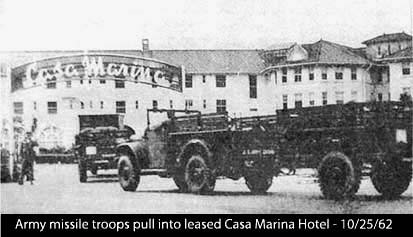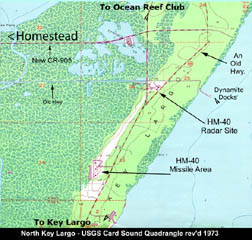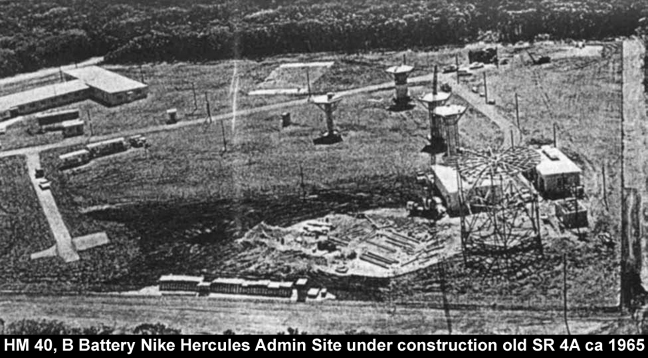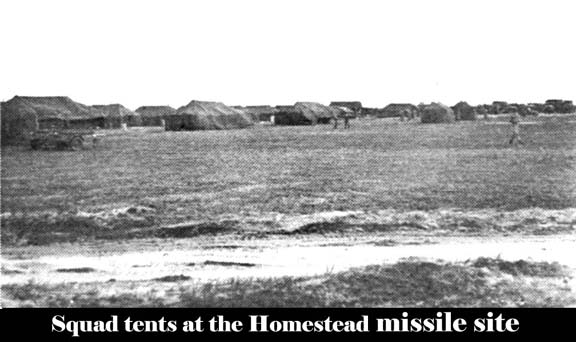Cuban Missile Key West
Keys Missile Site
I am of the opinion that the Cold War began at the Yalta Conference in 1945. Much has been written about this; therefore, one can come to their own conclusions. In summary, mine are that President Roosevelt and Prime Minister Churchill realized the powerful position that Premier Stalin was in and did the best that they could under the circumstances.
As in most wars, WW-II had generated a huge increase in military technology of air defense fighters, strategic bombers, jet powered aircraft and atomic bombs -- weapon systems. Germany lead the way in ballistic missiles such as the V-1 and V-2. These developments plus the Soviet apparent threat of world domination was countered by the U.S. developing counter forces to prevent another world war. Another consideration was to limit the damage incurred in such a conflict should occur.
The Army, Navy and Air Force had their roles in the defense of the nation. As a personal note, in 1950 I began my training in radar for the Air Defense Command (ADC) of the Air Force (AF), primarily in aircraft control and warning (AC&W) using fighter aircraft instead of missiles. The Army had it counter part, the Army Air Defense Command (ARADCOM), primarily missiles and antiaircraft guns. Both were part of the North American Defense Command (NORAD). These are defensive units, not strategic or tactical. The Soviet Union dominated the decision making process with its strategic bombers and ballistic missiles. At home, the federal budget was balanced between military and domestic needs.
The Hawk missile gradually replaced the antiaircraft gun for short range defense and the Nike Ajax for longer ranges.
Ideally the radar, control, command center and administrative site is separated about one mile from the missile launch site; albeit, the minimum separation is 3600 feet. Another problem to be dealt with was the booster rocket drop zone. The Nike had a solid propellant booster that could be dropped as near as one mile from the launch site. After release it fell where ever the momentum and wind took it. A totally above ground site required about 120 acres. If the launcher was below ground, 40 acres would suffice. There were 7 batteries in the Miami and Homestead area.
Some of the parameters of the Nike Hercules are: length = 41 feet; wingspan = 6 feet, 2 inches; diameter = 31.5 inches, range = 75 miles, altitude capability = 150,000 feet, weight = 10,710 pounds and speed = 2,707 mph.
As Soviet weapons improved, the U.S. weapons either improved are became obsolete. By 1974 most of the Nike Hercules sites were closed. The final coup de grace was the 1974 SALT treaty which prohibited weapons of this type. The shafts of the hydraulic launchers were physically cut to prevent operation.
To view a Nike Hercules missile CLICK HERE.
Then on October 22nd, President Kennedy announced that the Soviet "quarantine" ships would be stopped and a blockade ordered. The Strategic Air Command (SAC) went on active alert with nuclear bombers around the world. The 2nd Missile Battalion, 52nd Air Defense Artillery Group at Fort Bliss, Texas and the 6th Battalion (HAWK), 65th Artillery at Fort Meade, MD were dispatched to the Miami/Key West area.
On October 24th, the Soviet ships recognized the quarantine and stopped at sea. For the moment, all breathed a sigh of relief.
But it was only a sigh as after three days of tense cat and mouse games came "Black Saturday" - October 27, 1962. The Kremlin sent the message for the U.S. to remove its missiles from Turkey. The U.S. ignored the request, but Rudolph Anderson, the U.S. U-2 reconnaissance pilot was shot down and killed over Cuba. President Kennedy did not retaliate and for a resolution, Robert Kennedy and Soviet envoy Dobrynin met . The following day, October 28th, Premier Khrushchev accepted the proposals and history was made - the immediate crisis was over.
As in most wars, WW-II had generated a huge increase in military technology of air defense fighters, strategic bombers, jet powered aircraft and atomic bombs -- weapon systems. Germany lead the way in ballistic missiles such as the V-1 and V-2. These developments plus the Soviet apparent threat of world domination was countered by the U.S. developing counter forces to prevent another world war. Another consideration was to limit the damage incurred in such a conflict should occur.
The Army, Navy and Air Force had their roles in the defense of the nation. As a personal note, in 1950 I began my training in radar for the Air Defense Command (ADC) of the Air Force (AF), primarily in aircraft control and warning (AC&W) using fighter aircraft instead of missiles. The Army had it counter part, the Army Air Defense Command (ARADCOM), primarily missiles and antiaircraft guns. Both were part of the North American Defense Command (NORAD). These are defensive units, not strategic or tactical. The Soviet Union dominated the decision making process with its strategic bombers and ballistic missiles. At home, the federal budget was balanced between military and domestic needs.
The Hawk missile gradually replaced the antiaircraft gun for short range defense and the Nike Ajax for longer ranges.
- HAWK -
One of the first uses of the HAWK missile units were in Key West and the lower Keys for the Cuban Missile Crisis. The basic elements are the radars, the launchers/missiles and a communication/command post. The system can be divided into three sections: acquisition, fire control, and firing sections. Target detection from acquisition radar is provided to the fire control section radars for engagement evaluation. The fire control section locks onto the target with a tracking radar. A missile or missiles can be launched manually or in an automatic mode from the firing section by the fire control section. To view a Hawk missile launch unit CLICK HERE. To view miscellaneous photos related to the HAWK missiles that used to be located in Key West CLICK HERE.
- NIKE -
The NIKE-AJAX was the first ground based operational supersonic antiaircraft missile and was operational in the U.S. in 1955. When the entire system was improved and the missiles changed to solid fuels and the capability of a nuclear warhead it was known as the NIKE-HERCULES including by 1958. Solid fuels eliminated the troublesome and dangerous liquid rocket fuels. It replaced the Nike-Ajax systems between 1958 to 1963.Ideally the radar, control, command center and administrative site is separated about one mile from the missile launch site; albeit, the minimum separation is 3600 feet. Another problem to be dealt with was the booster rocket drop zone. The Nike had a solid propellant booster that could be dropped as near as one mile from the launch site. After release it fell where ever the momentum and wind took it. A totally above ground site required about 120 acres. If the launcher was below ground, 40 acres would suffice. There were 7 batteries in the Miami and Homestead area.
Some of the parameters of the Nike Hercules are: length = 41 feet; wingspan = 6 feet, 2 inches; diameter = 31.5 inches, range = 75 miles, altitude capability = 150,000 feet, weight = 10,710 pounds and speed = 2,707 mph.
As Soviet weapons improved, the U.S. weapons either improved are became obsolete. By 1974 most of the Nike Hercules sites were closed. The final coup de grace was the 1974 SALT treaty which prohibited weapons of this type. The shafts of the hydraulic launchers were physically cut to prevent operation.
To view a Nike Hercules missile CLICK HERE.
- CUBAN MISSILE CRISIS -
Albeit the Cuban Missile Crisis was only two weeks long, it will be remembered by many. One can go back as far as they like to develop the crisis, but it became obvious on October 14, 1962 when the photos from a U-2 reconnaissance aircraft revealed Soviet missiles in Cuba. The National Security Council was kicked into overdrive. The Russians maintained that they were for defensive purposes, but on the 19th, new aerial photos showed much larger missiles than needed for defense purposes.
I do not believe most of the nation knew how close we were to a massive nuclear war in 1962. I had just returned from Spain where we had three B-47 bomber bases. About a year before this and during the Berlin Wall crisis, I awoke one morning to the air field jammed with nuclear loaded B-52s. As all I did was drive by on my way to an off base radar site, but my guess would be 25 to 30 B-52s. The story was that there was about 60 aircraft in the air 24 hours a day. Russia was ringed with similar bases from England to Turkey.
Then on October 22nd, President Kennedy announced that the Soviet "quarantine" ships would be stopped and a blockade ordered. The Strategic Air Command (SAC) went on active alert with nuclear bombers around the world. The 2nd Missile Battalion, 52nd Air Defense Artillery Group at Fort Bliss, Texas and the 6th Battalion (HAWK), 65th Artillery at Fort Meade, MD were dispatched to the Miami/Key West area.
On October 24th, the Soviet ships recognized the quarantine and stopped at sea. For the moment, all breathed a sigh of relief.
But it was only a sigh as after three days of tense cat and mouse games came "Black Saturday" - October 27, 1962. The Kremlin sent the message for the U.S. to remove its missiles from Turkey. The U.S. ignored the request, but Rudolph Anderson, the U.S. U-2 reconnaissance pilot was shot down and killed over Cuba. President Kennedy did not retaliate and for a resolution, Robert Kennedy and Soviet envoy Dobrynin met . The following day, October 28th, Premier Khrushchev accepted the proposals and history was made - the immediate crisis was over.
- MISSILES IN SOUTHEAST FLORIDA -

- KEY WEST -

It could be asked why were there not defenses already in place, but there was not. The first to arrive was the more mobile and smaller ground-to-air Hawk missiles units at Key West. The 6th Battalion (HAWK), 65th Artillery, a unit of the joint STRIKE Command which had been stationed at Fort Meade, Maryland since August 1962. It received orders for a temporary change of station to Key West on October 20, 1962, two days before President Kennedy's quarantine challenge to Khrushchev; but owing largely to poor performance by the rail carrier, the movement (continued by road from Homestead AFB to Key West) was not completed until October 26, 1962. Even then it had to wait for its missiles which arrived by October 29, 1962. The battalion's Army Air Defense Command Post (AADCP) and four firing batteries were now fully operational and ready for action in defense of Key West. To view a missile unit on Smather's Beach, CLICK HERE.
The Army encountered further delays in mobilizing the physically larger Nike Hercules missile units for Miami and Homestead. The 2nd Missile Battalion, 52nd Air Defense Artillery Group received orders to move out on October 22, 1962. Its Battery B was at Johnson Island in a training exercise. Batteries A, C and D were in the rapid deployment mode at Fort Bliss, Texas. Personnel, radars, missiles, tents, vehicles, etc. were quickly loaded on trains. Within two weeks, they were encamped on Army Corps of Engineer prepared sites circling Miami and the Homestead Air Force Base. By November 14, 1962, all local Nike Hercules were operational. Battery B traveled to Homestead from Johnson Island via its home base at Fort Bliss, arriving in early November, 1962.
The above 1962 missile units were totally self-contained above ground mobile units. A time chart would clearly have shown that the mobile deployment speed was outdated for the nuclear age. Cuban Crisis was history before the missile units were fully operational. Few people knew that at the time. The Department of Defense brass decided to leave the southeast Florida Hawk and Nike missile batteries in place for the time being. Later, they decided to convert these Nike and HAWK sites into permanent sites. The Corps of Engineers was directed to purchase the land. Typically, Nike missiles in the launch area were stored sub-surface, then brought up on elevators and transported by rails to the launcher as needed. This was impossible in South Florida because the launch area was too close to sea level. The South Florida Nike units stored their missiles in huge barns on rails that extended to the outside firing pad.
Preservation efforts are being pursued to save a representative Nike site in the area of the entrance to the Everglades National Park west of Homestead.
The Army encountered further delays in mobilizing the physically larger Nike Hercules missile units for Miami and Homestead. The 2nd Missile Battalion, 52nd Air Defense Artillery Group received orders to move out on October 22, 1962. Its Battery B was at Johnson Island in a training exercise. Batteries A, C and D were in the rapid deployment mode at Fort Bliss, Texas. Personnel, radars, missiles, tents, vehicles, etc. were quickly loaded on trains. Within two weeks, they were encamped on Army Corps of Engineer prepared sites circling Miami and the Homestead Air Force Base. By November 14, 1962, all local Nike Hercules were operational. Battery B traveled to Homestead from Johnson Island via its home base at Fort Bliss, arriving in early November, 1962.
The above 1962 missile units were totally self-contained above ground mobile units. A time chart would clearly have shown that the mobile deployment speed was outdated for the nuclear age. Cuban Crisis was history before the missile units were fully operational. Few people knew that at the time. The Department of Defense brass decided to leave the southeast Florida Hawk and Nike missile batteries in place for the time being. Later, they decided to convert these Nike and HAWK sites into permanent sites. The Corps of Engineers was directed to purchase the land. Typically, Nike missiles in the launch area were stored sub-surface, then brought up on elevators and transported by rails to the launcher as needed. This was impossible in South Florida because the launch area was too close to sea level. The South Florida Nike units stored their missiles in huge barns on rails that extended to the outside firing pad.
Preservation efforts are being pursued to save a representative Nike site in the area of the entrance to the Everglades National Park west of Homestead.
- NORTH KEY LARGO -
Battery B remained at the Homestead until the Key Largo site could be purchased and prepared.
I am not certain precisely when the Key Largo Nike site was built but Battery B was relocated from Homestead to Key Largo in May and operational in June of 1965. All indications are that the Nike equipment was an up dated version. The new missile site designation was HM-40.
dated version. The new missile site designation was HM-40.
It appears that when the Key Largo site was first built, the old state highway to Ocean Reef was on the east side (ocean side) of the site. Actually this road was the original 1928 State Road 4A. In the 1960s to travel from Homestead to the Admin building, one would travel the U.S.-1 highway "18-mile Stretch" past Lake Surprise and double back, turn left, and travel toward Ocean Reef and the Angler's Club on then SR-905. Both these early highways preceded HM-40 by some time. The launch and radar sites are connected by underground cables; therefore, where possible they are usually on the same side of highways, canals, etc. as they were here when first constructed.
The correct nomenclature for the radar/administrative area is the Integrated Fire Control (IFC) area. The missile site is the Launcher area.
As the community of Ocean Reef grew, the road from Key Largo was upgraded. In the process for a more direct route, the new roadway was rerouted west of the radar site (IFC) in the late 1960s passing over the buried cables. This additional road placed the radar area in a triangle surrounded by roads.
I am not certain precisely when the Key Largo Nike site was built but Battery B was relocated from Homestead to Key Largo in May and operational in June of 1965. All indications are that the Nike equipment was an up
 dated version. The new missile site designation was HM-40.
dated version. The new missile site designation was HM-40.It appears that when the Key Largo site was first built, the old state highway to Ocean Reef was on the east side (ocean side) of the site. Actually this road was the original 1928 State Road 4A. In the 1960s to travel from Homestead to the Admin building, one would travel the U.S.-1 highway "18-mile Stretch" past Lake Surprise and double back, turn left, and travel toward Ocean Reef and the Angler's Club on then SR-905. Both these early highways preceded HM-40 by some time. The launch and radar sites are connected by underground cables; therefore, where possible they are usually on the same side of highways, canals, etc. as they were here when first constructed.
The correct nomenclature for the radar/administrative area is the Integrated Fire Control (IFC) area. The missile site is the Launcher area.
As the community of Ocean Reef grew, the road from Key Largo was upgraded. In the process for a more direct route, the new roadway was rerouted west of the radar site (IFC) in the late 1960s passing over the buried cables. This additional road placed the radar area in a triangle surrounded by roads.


